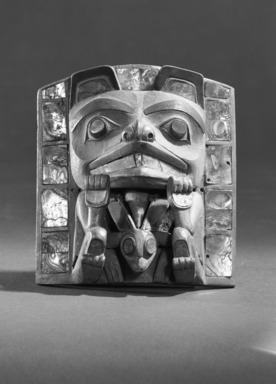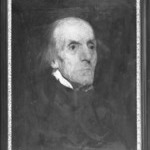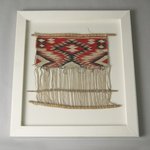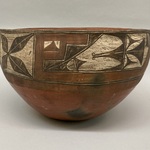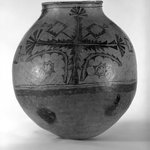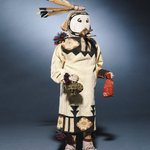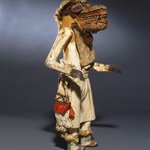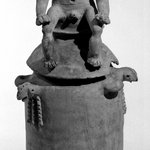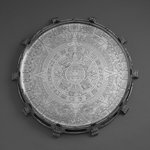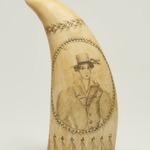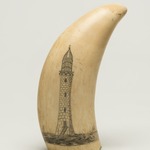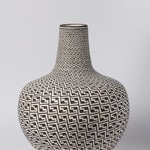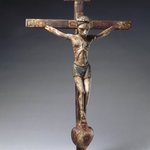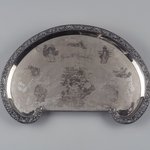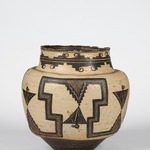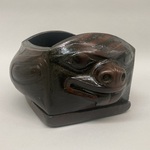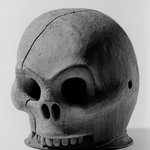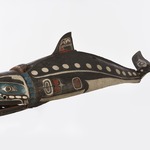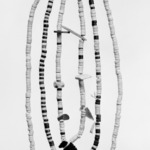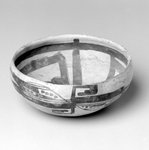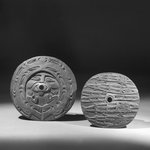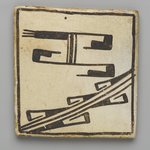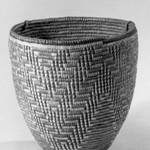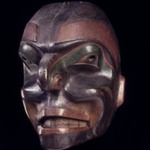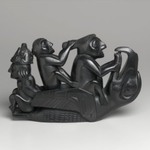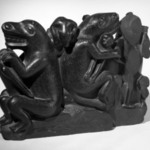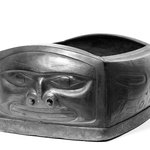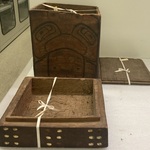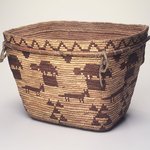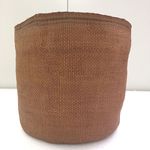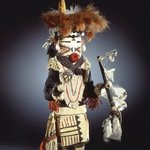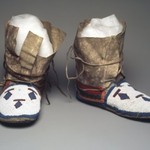Headdress Frontlet
Arts of the Americas
This type of frontlet would have been attached to a headdress made from ermine fur, wool, down feathers, skin, and sea lion whiskers. It depicts a bear overpowering an insect with a segmented body and wings behind its head and relates to a specific family crest. Headdress frontlets were, and still are, worn by a male or female chief during a dance to greet visitors to the village. Wearing an elaborate, woven blanket or apron and often carrying a rattle, the dancer would gracefully dip the headdress, scattering soft down over the visitor as a gesture of peace.
Charles Edenshaw was a well-known master carver who was among the first Haida artists to earn a living entirely from the works he created. His specific style can be identified through his unique eye-form. The eye itself is on a well-rounded orb, with a round iris enclosed in tapered lids with well-defined rims. There is no hollowing of the socket below the eye, and the cheeks of the figure are well-rounded, intersecting with the eye socket plane. Edenshaw's oeuvre was varied, consisting of full-size and small totem poles along with settees, cradles, carved crest figures for grave monuments, and silver bracelets. His great-grandsons, Robert and Reg Davidson, continue his artistic tradition today.
MEDIUM
Maple (Acer macrophyllum), Abalone shell (Haliotis refuscens and Haliotis fulgins), paint, fiber
DATES
late 19th century
DIMENSIONS
6 1/8 x 5 1/2 x 3 in. (15.6 x 14 x 7.6 cm)
(show scale)
ACCESSION NUMBER
50.158
CREDIT LINE
Gift of Helena Rubinstein
CATALOGUE DESCRIPTION
Headdress frontlet with a carved bear that can be identified by the depth of its eye sockets and the way its eyes are carved. The Bear appears to be overpowering an insect that has a segmented body and wings behind its head. Framing the carving along the sides and across the top are inset rectangles of abalone shell. Also inset with abalone are the bear's eyes, teeth and paws. The animal's face is blue-green with thick black outlined ears and heavy eyebrows. Its nose, mouth, and torso are red. The proper left edge of the frontlet was repaired and the wood backing for the abalone shell in this area was probably replaced. The object is in good condition.
The frontlet might have been hollowed out at the thickest part of the piece behind the face to prevent splitting. The blue-green color is frequently used among the Tlingit while defined eye sockets are frequently indicated by the Haida. Some pieces of abalone shell in this piece are lighter and pinker than other bluer pieces and these pinker pieces may have been replacement pieces for the original blue inlays.
MUSEUM LOCATION
This item is not on view
CAPTION
Charles Edenshaw (Haida, 1834–1924). Headdress Frontlet, late 19th century. Maple (Acer macrophyllum), Abalone shell (Haliotis refuscens and Haliotis fulgins), paint, fiber, 6 1/8 x 5 1/2 x 3 in. (15.6 x 14 x 7.6 cm). Brooklyn Museum, Gift of Helena Rubinstein, 50.158. Creative Commons-BY (Photo: Brooklyn Museum, 50.158_PS1.jpg)
IMAGE
overall, 50.158_PS1.jpg. Brooklyn Museum photograph, 2005
"CUR" at the beginning of an image file name means that the image was created by a curatorial staff member. These study images may be digital point-and-shoot photographs, when we don\'t yet have high-quality studio photography, or they may be scans of older negatives, slides, or photographic prints, providing historical documentation of the object.
RIGHTS STATEMENT
Creative Commons-BY
You may download and use Brooklyn Museum images of this three-dimensional work in accordance with a
Creative Commons license. Fair use, as understood under the United States Copyright Act, may also apply.
Please include caption information from this page and credit the Brooklyn Museum. If you need a high resolution file, please fill out our online
application form (charges apply).
For further information about copyright, we recommend resources at the
United States Library of Congress,
Cornell University,
Copyright and Cultural Institutions: Guidelines for U.S. Libraries, Archives, and Museums, and
Copyright Watch.
For more information about the Museum's rights project, including how rights types are assigned, please see our
blog posts on copyright.
If you have any information regarding this work and rights to it, please contact
copyright@brooklynmuseum.org.
RECORD COMPLETENESS
Not every record you will find here is complete. More information is available for some works than for others, and some entries have been updated more recently. Records are frequently reviewed and revised, and
we welcome any additional information you might have.


